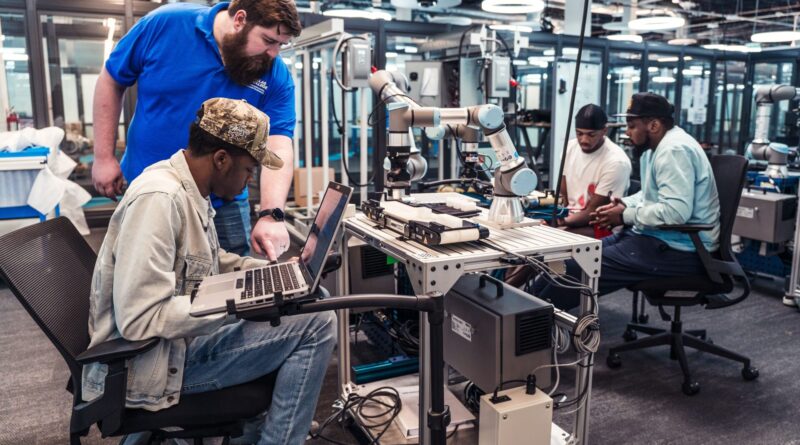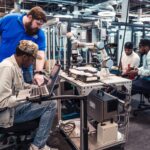Dallas College’s Mechatronics Program
Dallas College’s Mechatronics Program is setting students on fast tracks to lucrative careers through its partnership with Universal Robots (UR). By incorporating collaborative robots (cobots) into hands-on applications such as CNC machine tending, packaging and palletizing, students gain real-world experience in automation, preparing them to meet the demands of today’s evolving workforce. Dallas College’s Mechatronics Program.
“I told them I needed to graduate first.” Marcus Russell, a former student at Dallas College’s fast track mechatronics program, recounts how Walmart reached out to him six weeks into his 12-week program to hire him to program and operate the Universal Robots-powered palletizers at one of their facilities. He convinced the hiring managers to let him graduate first. “I also received offers from Tesla, but I didn’t want to move to Austin,” he adds, explaining how the local Walmart opportunity enabled him to transfer his newfound UR cobot knowledge straight into the workplace.
Impact Beyond the Classrooom
The program’s impact extends beyond the classroom. Russell says the skills he gained allowed him to train other employees at his workplace. “Now, even people who didn’t take the certification are learning from what I showed them,” he says.
Russell is one of many successful Dallas College graduates that the school’s professor in Manufacturing and Mechatronics, Bafford Howard, has seen through the program. “We’re trying to introduce learning that will jog the students’ imagination, take them to the next level,” he says, describing the many different cobot applications the school is developing:
“We’re creating a total environment that emulates what you see out in industry; we have cobots picking up boxes from large conveyor systems and palletizing them. We have mobile robots with cobot arms on top of them, we’re doing some VR (Virtual Reality) applications, we do CNC machine tending incorporating PLCs and Ethernet protocols, enabling the robots to communicate with each other.”
For Dallas College mechatronics students like Geoffrey Lockett, the program’s hands-on approach makes all the difference. “I’m not a traditional classroom learner,” he says. “Here, it’s all hands-on. I liked figuring out how to move the robot, rotate it, and pick things up. What you see on TV—it’s finally real.” His classmate Elisa Harris was surprised by how accessible the technology felt. “I thought it would be really complicated,” she says. “But most of it is on the tablet. It only took me a few minutes to start moving the arm and programming it to pick up boxes.”
Minimal learning curve and industry relevance
Ease of use is a big reason why Dallas College chose UR cobots. “The learning curve is minimal,” says Brian Turner, a mechatronics instructor at the college. “The interface is intuitive, which helps students grasp the basics of robot programming quickly.”
Aaron Paul, regional vice president of Advanced Technologies Consultants (ATC), provided the UR cobots at Dallas College. “Before we started working with UR, we sold a few industrial robots here and there, but we’ve now deployed UR cobots in hundreds of schools,” he says, adding that being easy to use is not the only success factor. “UR is the number one cobot in the industry, so they’re not just learning on a teaching robot. They’re learning on the robot they’re most likely to see in industry.”
Raphael Smith, dean of applied sciences at Dallas College, has followed the rise of cobots closely and emphasizes the importance of staying ahead of industry trends: “The cobot market is growing, and we want to reflect that. Our goal is to prepare students for what they’ll encounter in the industry both now and in the future.”
Dallas College also works directly with companies, providing employee training. Professor Howard says that several employees have received promotions after having trained on the UR cobots: “They have been able to move into different positions; Before they were technicians, now they’re supervisors.”
Empowering Educators and Enhancing Safety
Another benefit of cobots in the classroom is the quick adoption by faculty. The Dallas College dean explains how instructors are less intimidated by the robots due to their ease of use: “Instructors feel more confident in letting students work with the robots because they won’t be left answering questions they can’t answer,” he says.
This level of confidence is echoed by professor Howard, who recalls his own experience training experience: “My first class was virtual, due to COVID, but we were still able to program the robots and complete tasks. The system was straightforward and fun to use. It made learning about collaborative robots accessible, instead of doing line-by-line coding.”
The collaborative nature of Universal Robots means they can work alongside students without the need for protective barriers. “The robots stop if they encounter any resistance, so there’s no need for the rigid safety measures required by traditional robots. This makes them more accessible and safe to use in a classroom setting,” says Howard and explains: “If students bump into the robot, it stops, and the robot won’t continue until students are ready to re-enable it.”
Universal Robots’ EDU kit and Learning Management System
Dallas College uses Universal Robots’ EDU kits to get students introduced to cobots and have them graduate with a Universal Robots certification. The kit typically includes a UR3 or a UR5 cobot model and comes with components such as table-top conveyors, 3D-printed parts, that allow students to practice tasks like pick-and-place operations.
“I love the small-scale version,” says Mechatronics instructor at Dallas College, Brian Turner. “It’s eye-opening because now we can transfer them to a bigger scale version without them feeling intimated,” he explains, referencing the college’s larger, ‘real’ factory setting where UR10 and UR20 cobot models pick boxes from conveyors and either palletize them or place them on autonomous mobile robots (AMRs) from Mobile Industrial Robots.
The EDU kits come with UR’s Learning Management System (LMS), which offers comprehensive lab exercises. Once instructors are certified, they gain access to the LMS, which provides all the tools they need to guide students through the curriculum and help them earn the certification.
“The LMS is a real cutting-edge technology curriculum,” says Turner. “It’s laid out with modules that break down everything with animations and step-by-step instructions.” Before students get to the LMS, they can go through the UR Academy modules open to anyone with an internet connection. “That curriculum was top-notch to me,” says professor Howard. “We can ask the students to study up on Academy modules at home and when they come to school, we turn them loose in the lab with the LMS and the certification kits.”
‘The UR robot becomes your pencil’
Despite its ease of use, Universal Robots offers advanced capabilities that allow students to tackle complex industry tasks. “The robots are simple to learn, but that doesn’t mean they’re simplistic,” explains Paul. “Students are able to do more complex things that you would see in industry, – tasks that can be more challenging on other systems. It’s also easy to connect the UR robots to external devices because of the input and outputs.”
Ife Okwumabua started out as a mechatronics student at Dallas College but is now a teacher assistant in the program. He has experienced first-hand how the UR platform encourages creativity and problem-solving: ” Effectively, the UR platform now is your pencil,” he says. “I get this crazy idea and I will actually start sketching it out. Then I ask my professor whether this will translate into industry. And he will respond ‘yes but keep these patterns in mind.’”
Support just a call away
It’s critical that students always have access to all the UR robots at Dallas College. Professor Howard emphasizes how technical support through ATC and UR has been outstanding: “Whenever we have issues, they’re right there. It’s just a phone call away. Not in a call center or anything like that. They ask the right questions and they get us going again,” he says, recalling an issue with a teach pendant. “We let them know and the next day, we had a new teach pendant, overnight. That’s very unusual in the industry.”
Future Applications and Growth
The Dallas College dean says the school will continue to invest in cobots. “We will get larger cobots and larger inside facilities inside, so that we can continue to train our students for new cobot environments,” he predicts.
For those who might feel robotics is out of reach or end up stealing people’s jobs, Marcus Russell has a message: “Watch what I’ve done. Universal Robots can take anybody that has enough imagination and turn them into a programmer,” he says, adding: “A lot of people are worried about robots taking their jobs, But if you’re fixing and programming the robots, there’s going to be more jobs for that. So people just need to change their mind about what type of job and career path they want to get in.”
Source: Dallas College’s Mechatronics Program
About Universal Robots
Universal Robots is a global leader in collaborative robotics (cobots), used across a wide range of industries. Our mission is simple: Automation for anyone. Anywhere. Over 90,000 cobots sold worldwide. Our user-friendly platform is supported by intuitive PolyScope software. Award-winning training, comprehensive services, and the world’s largest cobot ecosystem, delivering innovation and choice to our customers. Universal Robots is part of Teradyne Robotics. A division of Teradyne (NASDAQ:TER). The leading supplier of automatic test equipment and advanced robotics technology.
www.universal-robots.com
https://www.techedmagazine.com/category/news-by-industry/manufacturing-education/


